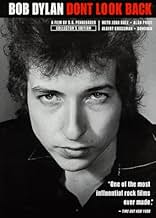Documentary covering Bob Dylan's 1965 tour of England, which includes appearances by Joan Baez and Donovan.Documentary covering Bob Dylan's 1965 tour of England, which includes appearances by Joan Baez and Donovan.Documentary covering Bob Dylan's 1965 tour of England, which includes appearances by Joan Baez and Donovan.
- Awards
- 4 wins
- Self
- (uncredited)
- Self - science student
- (uncredited)
- Self
- (uncredited)
- Self
- (uncredited)
- Self
- (uncredited)
- Self
- (uncredited)
- Director
- Writer
- All cast & crew
- Production, box office & more at IMDbPro
Storyline
Did you know
- TriviaThe scene where Donovan visits Dylan in his hotel was generally viewed as Dylan putting the young singer-songwriter in his place when he grabs the guitar and performs "It's All Over Now, Baby Blue." But a 2015 Criterion Collection remaster, with improved sound, revealed that Donovan actually requested Dylan play that song for him. That gave the entire scene a new meaning and revealed Dylan and Donovan as more friends than rivals.
- Quotes
Albert Grossman: They've started calling you an anarchist.
Bob Dylan: Who?
Albert Grossman: The papers. That's the word now.
Bob Dylan: Anarchist?
Albert Grossman: Right. Yeah.
Bob Dylan: The newspaper's say I'm an anarchist?
Albert Grossman: Two or three. Just because you don't offer any solutions.
Bob Dylan: You're kidding!
Albert Grossman: Of course.
Bob Dylan: Anarchist? Huh? Give me a cigarette. Give the anarchist a cigarette. Anarchist? A singer such as I.
- ConnectionsFeatured in Precious Images (1986)
In other words, this is not a portrait of the artist that I happen to like, but it is the truth (or at least it was at that time). In addition, Albert Grossman, Dylan's manager, is shown in possibly the least flattering light possible. A bonus is that the film begins with the brilliant 1965 promotional clip for "Subterranean Homesick Blues", and watch for the scene in a hotel room when Dylan and Bob Neuwirth sing "Lost Highway" - it's worth the price of admission.
- How long is Bob Dylan: Dont Look Back?Powered by Alexa
Details
Box office
- Gross US & Canada
- $27,158
- Runtime1 hour 36 minutes
- Color
- Sound mix
- Aspect ratio
- 1.37 : 1
Contribute to this page



































